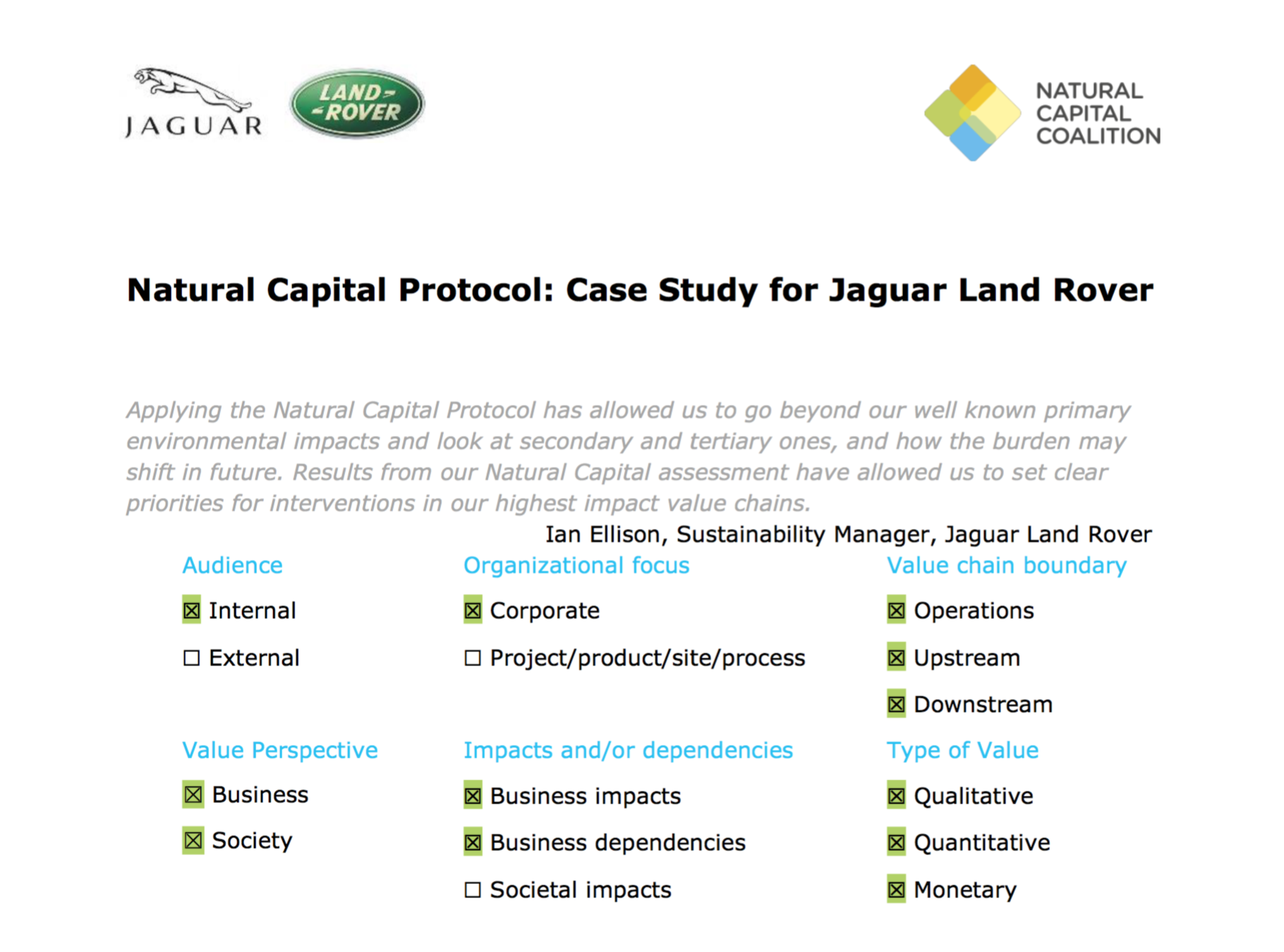The company in brief:
Jaguar Land Rover (JLR) is a British multinational automotive company, a subsidiary of Indian automaker Tata Motors. Jaguar Land Rover designs, develops, and manufactures vehicles bearing the Jaguar and Land Rover marques. The company has been performing Life Cycle Assessment (LCA) since 2008, including for product-to-product materiality comparisons as well as year- on-year analyses of material inputs. LCA as a methodology is well understood by Jaguar Land Rover’s in house team.
Jaguar Land Rover also applies a number of industry accepted modelling tools (e.g. Thinkstep GaBi) which it recognises as useful, but also not prescriptive, nor consistent in the industry. Conscious that the methods it was using were bespoke, the business wanted to apply an externally accepted approach, something recognised – hence the application of the Natural Capital Protocol.
Why a natural capital assessment?
Jaguar Land Rover’s high level goals were ambitious: aspirations to optimise strategy, make better decisions, realise performance improvements, and embed sustainability within the business. However, the company was realistic about what it could achieve first time round, and saw Protocol implementation as a process of “mapping the territory” to identify areas of specific focus for further assessment. Ideally Jaguar Land Rover wanted to develop forward looking approaches that it could use to model scenarios for sustainable growth.
One objective of Jaguar Land Rover’s Natural Capital assessment was to compare and extend outputs from the tools that it was already implementing.
The business was aware that such methodologies had limits, and that the reporting delivered was masking certain material impacts and dependencies. Jaguar Land Rover was keen to find out what was missing, and acknowledged that while traditional approaches can provide valuable information, they do not always provide engineers with the fully comprehensive picture that is needed to take informed, robust decisions.
How was the Natural Capital Protocol used?
Jaguar Land Rover applied all of the Scope, Measure, Value and Apply stages of the Protocol. It adopted a business and societal focus, that addressed impacts and dependencies for its whole corporate value chain. In terms of target audience, the company’s main interest was for business internal purposes, as opposed to marketing to external stakeholders. While Jaguar Land Rover performed much of the Scoping and Measurement stages in-house, it opted for consultant input for translating their outputs into monetary values.
In addition to direct operations, Jaguar Land Rover looked at the upstream value chain all the way to raw material inputs, and the downstream value chain as far as customer end-use of their vehicles. This enabled the company to assess the relative materiality of all impacts, over the complete product life cycle, and then analyse each stage individually in terms of risks and opportunities, to see where it made most sense to intervene with improvement measures.
What were the outcomes of the assessment?
Jaguar Land Rover found that application of the Protocol confirmed its key impacts and dependencies. GHG emissions were, as expected, the largest material impact, particularly when both vehicle manufacture and downstream vehicle use by customers were included in the measurement. After this, the next largest was embedded impact in materials, from all upstream tiers of the value chain. While impacts from metal inputs such as steel and aluminium were already appreciated, magnesium and certain plastics were illuminated as materials that were energy intensive relative to their overall weight in a vehicle.
In terms of key benefits, Jaguar Land Rover found that not only did the Protocol extend and enhance the outcomes of their existing LCA, but that natural capital valuation facilitated the prioritisation of business challenges around resource inputs. It answered questions with a dual societal and commercial focus, such as in the case of aluminium, for which valuation was able to demonstrate not only a real cost saving to the business through recycling, but also societal benefit in terms of a reduction in waste.
Jaguar Land Rover found that the Protocol provided them with another lens of information with which to evaluate business strategy, one that can be used alongside information on market and customer expectations. By taking periodic accounts of impacts and dependencies, the company has been able to build a model from which the influence of natural capital on future vehicle fleets can begin to be predicted. Jaguar Land Rover has been able to integrate this with scenarios related to business expansion and changing customer expectations, through to 2030.
Next steps
In the future Jaguar Land Rover would like to focus use of the Protocol on specific areas for more granularity and accuracy. One area of interest is in better scoping supply chain geography, a move that would permit the company to acquire more knowledge of material sourcing.
Jaguar Land Rover recommends the gradual introduction of natural capital terminology into business conversations as very important to ensuring effective delivery. Engineering personnel appreciate tangible, science-based targets and the language used should hence reflect the language of the organisational culture. The business found that aiming initial natural capital assessments at improved decision making and better internal understanding of impacts helped gain the interest of senior stakeholders.
Jaguar Land Rover recognises that applying the Protocol involves a lot of data, not all of which is easily available, especially if it is several tiers into a supply chain. Its advice for prospective Protocol users is that in the absence of a comprehensive starting data set (e.g. mature LCA analysis and/or input/output reports, etc.) consider trying a pilot on a limited scope (e.g. single product, site or service). This may require several iterations before data is robust enough to make decisions.
Finally, Jaguar Land Rover understands that a gap exists between how regulations currently require companies to act in terms of their management of natural capital, and the science in terms of medium to long term projections for natural capital risks and opportunities. The business believes that it is prudent to understand that gap more clearly, and to design a strategy to manage impacts and dependencies that reduces risk and leads to increased resilience for their business.








